Ancient Inventions That Shaped the Modern World: Enduring Legacies of Ingenious Minds
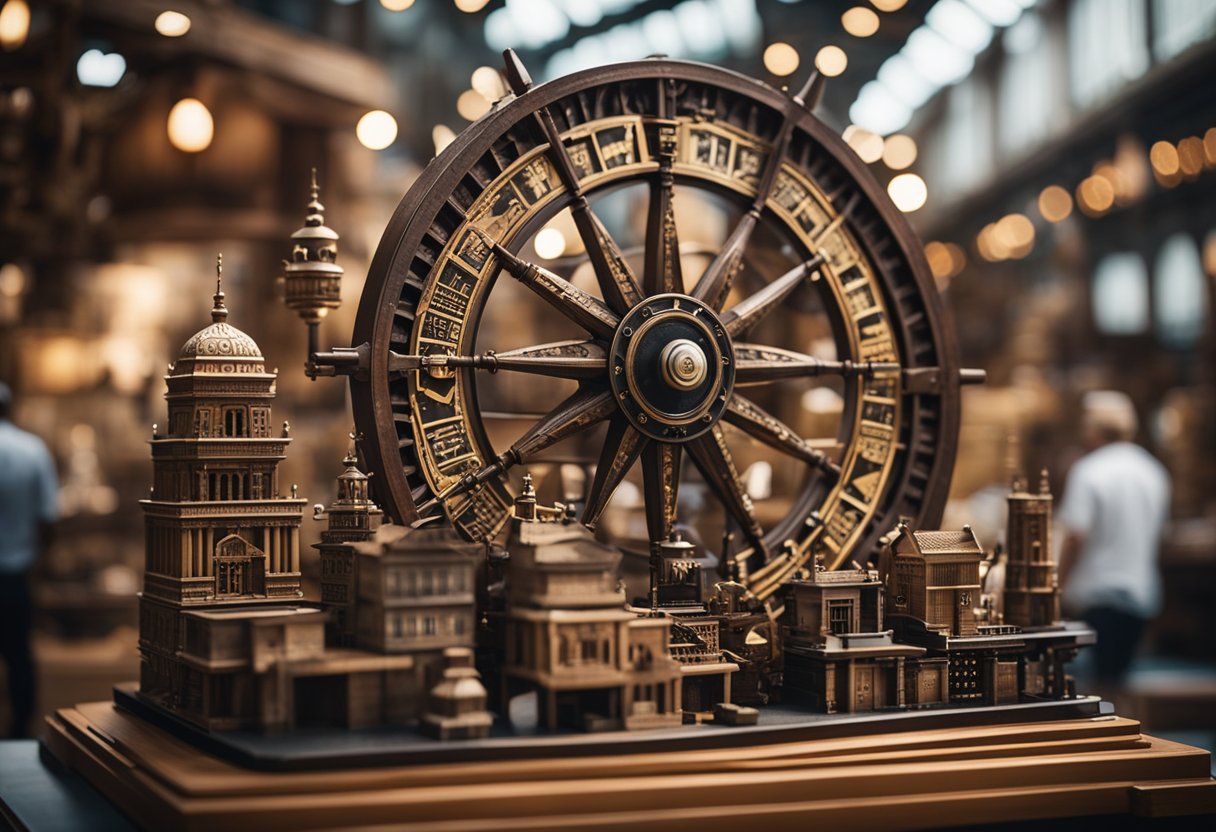
Updated On: April 24, 2024 by Yomna Salah
Throughout history, ancient civilisations and ancient inventions have laid the groundwork for contemporary life as we know it, pioneering innovations that continue to underpin our daily existence. From the foundational aspects of engineering to the complex systems of water management and sanitation, their ingenious methods have not only survived the test of time but have also become integral components of our modern infrastructure. The Romans, for example, were instrumental in creating durable concrete, which remains a staple material in construction around the world.
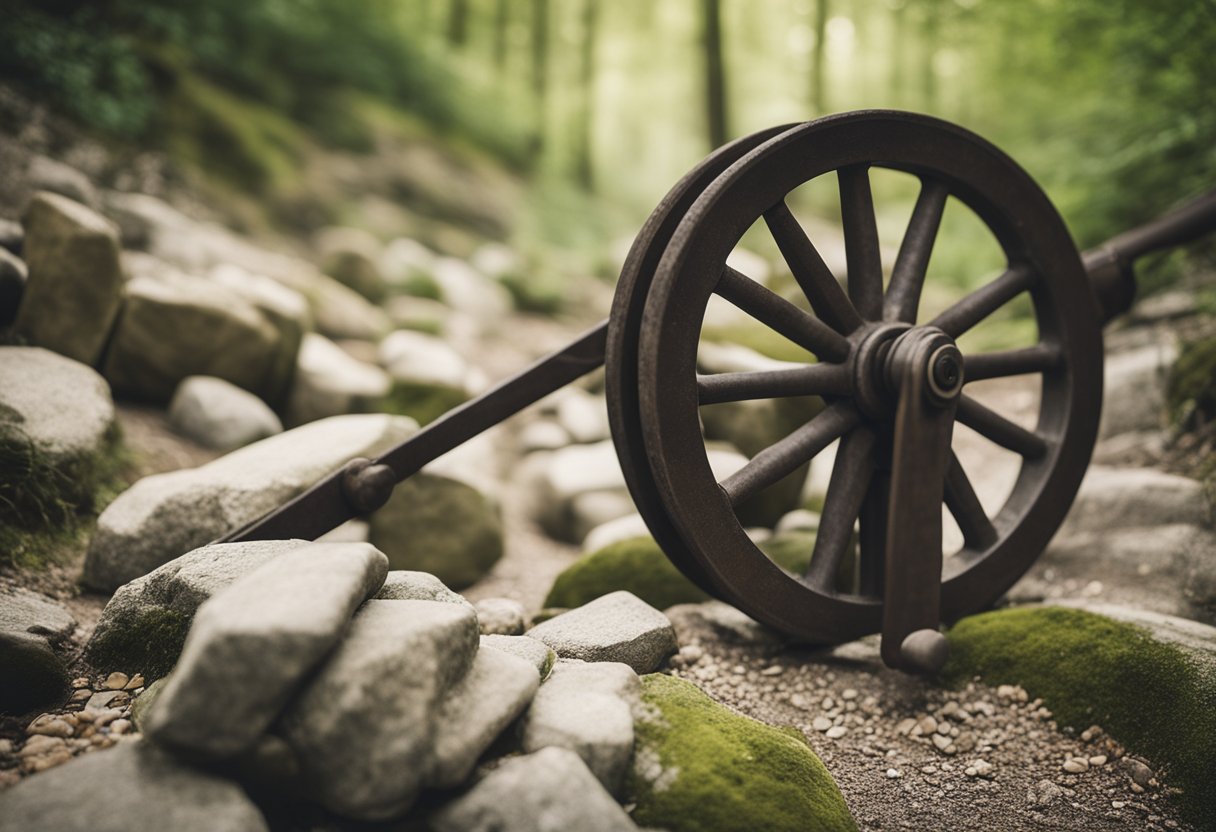
The Foundations of Engineering
Ancient innovations laid the groundwork for modern engineering, with monumental advances in materials and construction techniques that have stood the test of time.
Invention of Concrete and Opus Caementicium
Ancient Rome laid the foundation for modern construction by pioneering the use of concrete. This mixture included lime, water, sand, volcanic ash, and stones. The Roman concrete formula expanded architectural possibility with opus caementicium, revolutionising the way buildings were constructed.
Architecture’s Leap: Arches and Domes
The mastery of arches and domes signified a quantum leap in architecture. These designs not only supported more significant weight but also transformed urban landscapes, giving rise to celebrated structures like the Colosseum.
Engineering Fields and Techniques
Early engineering marvels encompassed various fields, including civil engineering. They utilised advanced techniques to build cities, develop complex road networks and construct aqueducts, illustrating the vast scope of ancient engineering prowess.
The Indelible Impact of Roman Roads
Roman roads intertwined far-reaching corners of the empire, proving that durable and extensive road networks were central to civilisation. Their meticulous construction, consisting of multi-layered materials, set standards in road-building that have echoed through technology and engineering disciplines for centuries.
Water Management and Sanitation
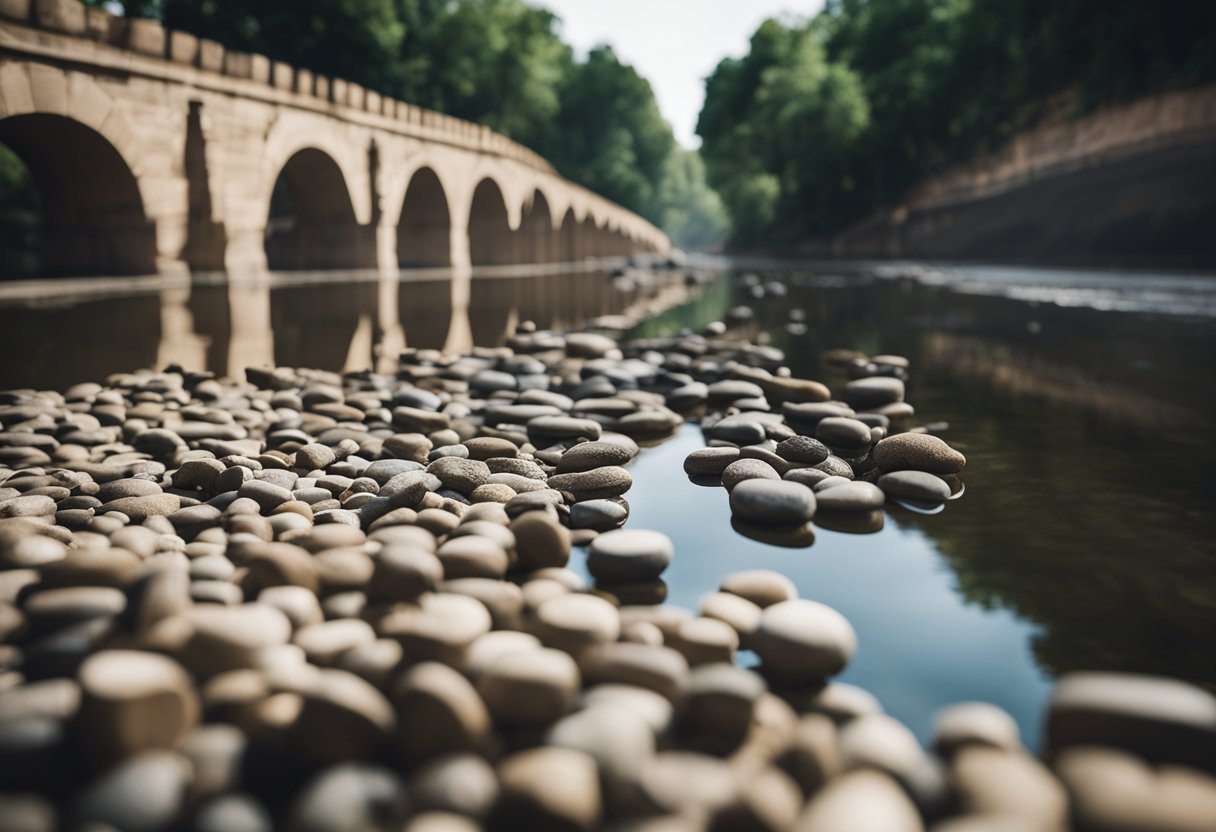
Ancient civilisations set the foundation for modern water management and sanitation systems with their innovative use of aqueducts and sewage systems that leveraged gravity and engineering prowess.
Aqueducts: The Flow of Progress
Aqueducts are monumental examples of ancient ingenuity, acting as arteries of life across empires such as Rome. These structures harnessed the force of gravity to transport water over vast distances, supporting the hydration and hygiene of burgeoning urban populations. The construction of aqueducts required precise planning to maintain a slight gradient, ensuring a continuous flow of water across varying terrains. Detailed records from ancient times reveal that these waterways were not solely about utility; they also symbolised the prosperity and sophistication of the society that built them.
Revolutionising Sanitation: Sewage and Underfloor Heating
Turning our attention below ground, we see that the sewage systems of ancient civilisations were remarkable advancements that protected public health and paved the way for large urban centres. For example, the enduring sewer system that began over 2,600 years ago, which is still operational today, is a testament to the timeless competence in the design and construction of sanitation infrastructure.
Moreover, the Romans employed the hypocaust system — an ingenious method of underfloor heating that further revolutionised sanitation and comfort in dwellings. By elevating floors on pillars, hot air from wood-fired furnaces would circulate beneath the floors and within wall cavities, not only warming the rooms but also drying out moisture that could otherwise contribute to unhealthy conditions.
From the aqueducts’ cascading waters to the unseen but crucial sewers, our ancient ancestors employed the natural forces of gravity and water cycles to establish the very essence of modern sanitation and water management systems. These advancements have set in stone the principles of public health and urban planning that remain relevant to this day.
Agriculture and Food Production
In transforming from nomadic communities to settled societies, our forebears crafted agricultural practices and tools that still underpin modern food production.
Tools and Techniques for Cultivation
The invention of the plough marked a revolution in agriculture, dramatically changing how we cultivate land. Turning the soil improved the environment for plant roots and helped control weeds, paving the way for increased production of critical crops like wheat. The development of agricultural methods, such as crop rotation and selective breeding, allowed us to enhance yields and food quality, which in turn supported larger populations.
- Ploughs: Facilitated turning and loosening of soil
- Crop Rotation: Preserved soil fertility
- Selective Breeding: Improved crop characteristics
Storage and Preservation Methods
The key to the success of a settled life is the ability to store and preserve food, enabling us to thrive in times of scarcity. Methods such as drying, smoking, and salting improved the longevity and safety of foodstuffs. Moreover, the construction of granaries provided a means to store large quantities of grains like wheat, securing food supplies through seasons and bad years.
- Granaries: Essential for large-scale grain storage
- Salting: Extended the preservation of meat and fish
- Drying and Smoking: Reduced moisture in food, preventing spoilage
Our knowledge of food preservation not only ensured continual sustenance but also laid the foundations for culinary diversity and trade.
By navigating the link to earlier agricultural advancements and their influence on today’s methods, we gain an appreciation for the shaping of our current food production processes.
Transportation and Communication Networks
Ancient advancements in transportation and communication have laid the groundwork for the interconnected world we enjoy today. These sectors saw a dramatic shift from rudimentary methods to sophisticated networks that efficiently moved people and information across vast distances.
From Chariots to Roads: A Transportation Revolution
The innovation of wheeled transportation, particularly chariots and carts pulled by horses, marked a significant leap in how humans travelled and traded. Our ancestors were not content with the mere invention of vehicles; they embarked on the ambitious enterprise of road construction, facilitating travel and transportation on an unprecedented scale. These roads were often constructed with impressive engineering techniques, ensuring durability and expanding the reach of trade and military expeditions.
The Cursus Publicus and the Spread of Information
As essential as the physical transportation of goods and people was the swift movement of information. The cursus publicus, or the public messenger service of the Roman Empire, was a complex network designed to carry official communications and personnel. Utilising state-provided horses and chariots, this system significantly increased the speed at which commands, news, and intelligence were disseminated throughout the provinces, thereby enhancing governance and order across the vast Empire. It underscores how vital communication networks were to the administration and cohesion of ancient societies.
Military Advances and Weaponry
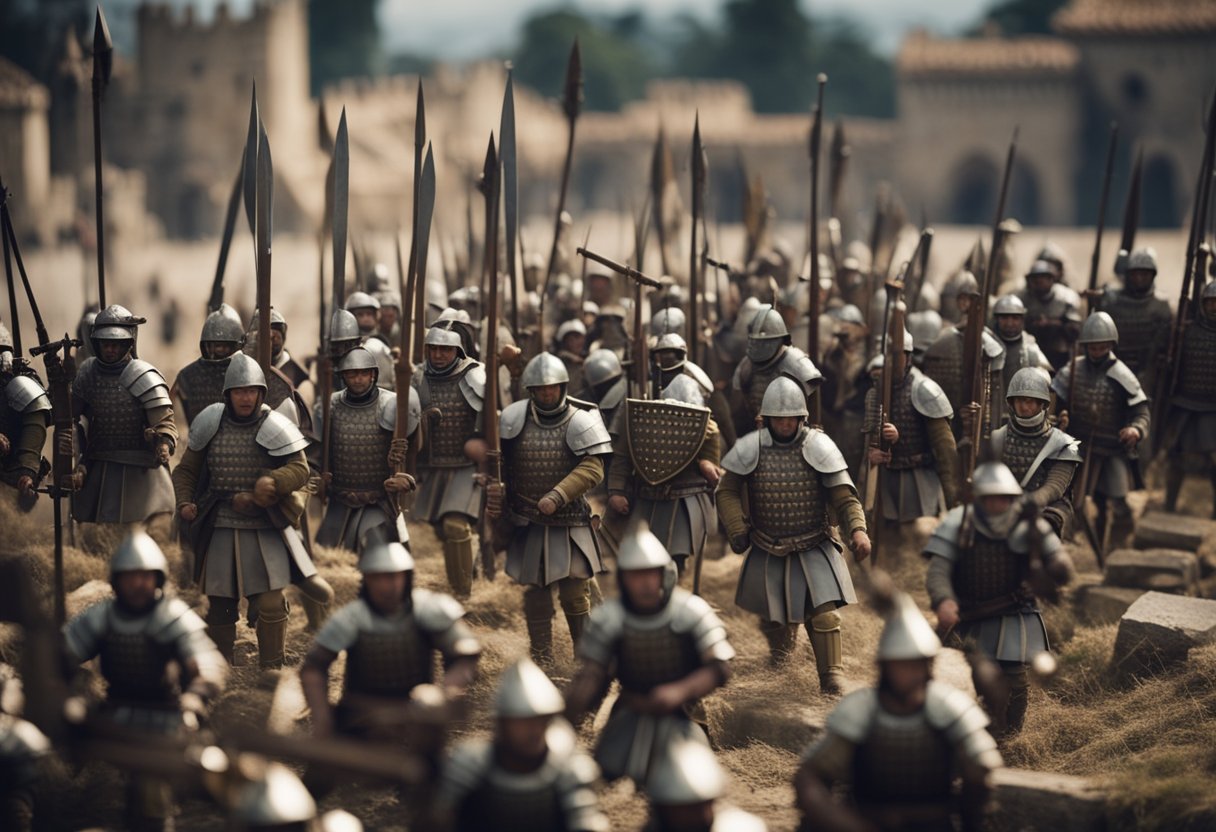
Through the ingenuity of ancient civilisations, particularly the Romans, military advancements have deeply influenced the modern world. Their mastery in military engineering and the development of sophisticated weaponry have set the foundations for contemporary strategies and constructions.
Fortifications and Engineering
Roman Military Engineering: We recognise the Romans for revolutionising military fortifications, employing advanced techniques to protect and assert their dominance across Europe and beyond. Their construction of robust defences, such as Hadrian’s Wall, exemplified an unparalleled understanding of engineering in warfare. Roman siege tactics often involved circumvallation and contravallation, tactics that involved constructing lines of fortifications around enemy fortresses and their own camps, respectively.
- Circumvallation: Encircling a besieged fort with a temporary wall.
- Contravallation: Building a second line of defence around the besiegers to prevent a surprise attack.
These methods not only provided a strategic advantage but also manifested the might of the Roman military apparatus.
Developments in Armaments and Strategy
Weaponry: The Romans not only excelled in defensive tactics but also in the advancements of their armaments. The gladius and pilum were among the quintessential weapons wielded by Roman legionaries, proving to be effective tools in close combat and as throwing weapons, respectively. The design and utility of these weapons informed future military developments around the globe.
- Gladius – A short sword designed for stabbing during close engagements.
- Pilum – A heavy javelin utilised to disrupt enemy formations before a melee.
Military Strategy: We credit the Romans with innovating military strategy, blending the use of heavy infantry with a sophisticated hierarchy and an emphasis on discipline within their legions. The manipular legion formation, an early Roman formation adopted from the Samnite tribes of Italy, allowed for a flexible and formidable offensive line capable of adapting to the changing tides of battle. It showcased the strategic deployment of cohorts and centuries that paved the way for the future of organised military conflict.
Artistic Contributions and Iconography

In the domain of ancient civilisations’ influence on the modern world, their artistic contributions and the symbolic iconography they left behind play pivotal roles. These aspects have deeply influenced the aesthetic and intellectual fabric of contemporary society.
Inspiration Drawn from Ancient Cultures
Ancient cultures have been a boundless wellspring of inspiration for modern art. The classics of Greece and Rome have bequeathed us not only with monumental sculptures and architecture but also with principles of beauty and proportion that resonate to this day. It is in the frescoes, the mosaics and the very motifs that endured across centuries that we trace the lineage of our artistic tenets.
Moreover, the rich tapestry of Latin language and literature forms the substratum of Western literary tradition. Countless artists and authors have drawn from this heritage, often paying homage to the mastery of narratives like those of Ovid, whose works have permeated through time with as much relevance and reverence now as they had in antiquity.
Legacy in Art and Literature
Whether it’s through the disciplined beauty of a Latin couplet or the evocative power of a mythological scene rendered in marble, ancient iconography has cemented its legacy within modern art and literature. Ovid’s “Metamorphoses,” for instance, not only remains a seminal text in the Western literary canon, but it also serves as an inexhaustible vault of motifs and archetypes. It’s the timeless stories within these pages that have offered a framework upon which countless modern literary works and artworks have been structured.
In literature, the ancient world’s propensity for storytelling has been inherited and adapted into countless languages, with the narratives often serving as the skeleton for new creations that reflect current values and perspectives. Similarly, in art, the stylistic and thematic inspirations drawn from the classical world are evident in movements ranging from the Renaissance to Neoclassicism and even modern design in subtle allusions or overt recreations.
Legal Systems and Governance

As we explore the historical tapestry of legal systems and governance, it’s evident that innovations from ancient civilisations deeply influenced modern administrative and legislative frameworks. The legacy of Roman law and the governance structure of ancient Rome have notably shaped contemporary legal practices and political systems.
Influences of Roman Law
The Roman Empire was monumental in framing the structure of modern legal systems. Roman law introduced the concept of civil law, which is still used as a foundation in many countries today. Legacy elements like legal terminology and the codification of laws derive from Roman precedents. Notably, the Twelve Tables and later compilations, such as the Justinian Code, served as comprehensive references that outline civil obligations and procedures.
Julius Caesar, a pivotal figure in Roman history, set precedents for governance through his centralisation of power and reformation of policies that affected administrative functions. Caesar’s changes to Roman governance demonstrated the capability of a strong central authority to enact widespread social and legal reform.
Administrative and Political Innovations
Administrative and political innovations from ancient times have enduring impacts on our understanding of governance. The methodical and hierarchical structures used to manage vast territories during the eras of empires have influenced modern bureaucratic systems. These ancient governments showed that effective administration requires an organised civil service, a notion that persists in our governance models today.
Furthermore, the Roman Republic, before the time of Julius Caesar, introduced the concept of representative governance with the Senate and the Assembly, laying the groundwork for legislative bodies in modern democracies. Their approach to governance through elected officials and checks and balances set a precedent that informs the political institutions and representative democracies we see around the world.
Trade, Economy, and Industry

In the evolution of civilisation, the development of trade, economy, and industry has been a fundamental force. These components are intricately linked, each fueling advancements and shaping societies since the dawn of time. Let us explore how commercial networks expanded economic boundaries and how industries fostered technological innovation.
Commercial Networks and Economic Expansion
Trade has always been the lifeblood of economic expansion. Historically, commercial networks bridged the gap between different civilisations, facilitating the exchange of goods and services. Ancient trade in Mesopotamia marked the beginning of such networks, with trade routes expanding as far as the Indus Valley by around 3000 BC. These routes allowed for increased interactions between diverse cultures, resulting in a robust economic structure that transcended local communities. The Phoenicians, for example, were instrumental in spreading trade across the Mediterranean as they established cities and outposts, enhancing their trade influence.
- Trading goods like ceramics, textiles, and precious metals helped forge economic partnerships.
- Coins were introduced by the Lydians, which standardised trade and helped establish a system of fair exchange.
Industries and Technological Innovation
The rise of industry is undeniably tied to technological progress. Mesopotamia, once again, serves as a prime example of the inception of industry and technology. They were pioneers in manufacturing, utilizing resources like wool from domesticated animals and developing large-scale textile productions. These industries were bolstered by significant technological innovations such as the wheel and sail, boosting transport and trade capabilities.
- Pottery, metallurgy, and shipbuilding emerged as significant industries, encouraging economic growth and bolstering military strength.
- The implementation of the Code of Hammurabi provided a legal framework that supported fair trade practices and protected property rights, further stabilising the economy.
By dissecting the intricate web of trade, economy, and industry in the ancient world, we understand how they collectively laid the foundation for modern society. These early advancements have allowed us to progress and reach new heights of globalisation and interconnectedness in our industry and economy.
Medical Advancements and Public Health

The contributions of ancient civilisations to today’s medical practices and public health policies have been fundamental in shaping modern society. These advancements have laid the groundwork for a better understanding of disease prevention, treatment, and the overall promotion of health.
Surgical Tools and Medical Practices
The development of surgical tools and techniques has been influential in improving patient outcomes. For instance, Ancient Greeks honed the practice of surgery, where physicians like Hippocrates laid down principles that guided medical thinking for centuries. Today’s surgical steel instruments can trace their lineage back to the bronze and iron tools used by these early practitioners. The elaborate procedures of the past, albeit crude by today’s standards, were pivotal in advancing medicine from a practice shrouded in superstition to one grounded in observation and study.
Practices such as hygiene, which were once spiritual rites, have now been proven by science to be essential in preventing infections. This understanding has led to the modern protocols of antiseptics and sterilisation of surgical instruments, dramatically reducing the risk of postoperative infections.
Public Health Policies and Their Outcomes
Public health policies, at their core, aspire to prevent disease and promote the well-being of populations. Identifying major historical trends, Ancient Greek civilisation contributed not only to individual patient care but also to public health. Their implementation of sanitation systems—such as aqueducts and sewage disposal—has been emulated and improved upon for public health initiatives, including widespread access to clean water.
The creation and subsequent enforcement of public health laws can be traced back to these times, when public gatherings, the cleanliness of cities, and food safety were regulated. The outcomes of such policies over the centuries have been significant, with metrics such as life expectancy and quality of life improving in cohorts that have access to structured public health systems. The emphasis on public hygiene has also continued to influence public health strategies, showing the longevity and impact of these ancient practices.
By understanding our past and optimising these long-standing concepts, we continue to evolve and advance health across our societies.
Cultural Exchange and Global Influence
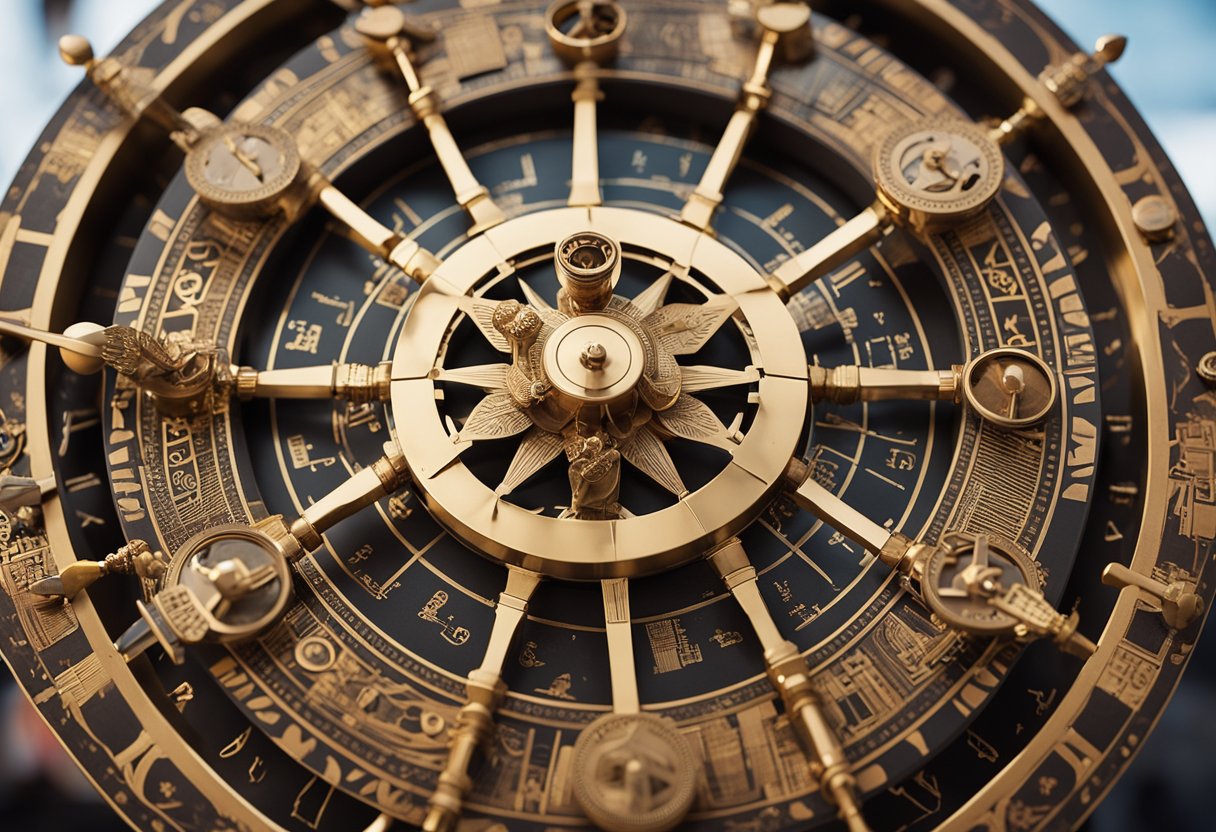
As we explore the ancient innovations that have shaped our modern world, it is imperative to understand the pivotal roles of cultural exchange and global influence. Through these processes, civilisations have shared knowledge, integrated cultures, and adapted technologies, leading to advancements that transcend time and borders.
The Spread of Knowledge and Technology
The ancient Silk Road was not only a series of trade routes but also a conduit for the exchange of ideas and expertise. Radiating from Central Asia, it connected China to the Mediterranean, fostering a technological passage that helped propel societies into the Modern Age. The flow of inventions along these routes, such as papermaking, compass navigation, and printing, demonstrates the profound impact of interconnected civilisations on collective progress. The Silk Road witnessed myriad forms of knowledge transfer that have indelibly influenced various aspects of contemporary life.
Cultural Integration and Adaptation
Cultural integration can be seen in the enduring legacy of the Roman Empire. The empire’s far-reaching influence has left a mark on modern culture, architecture, technology, literature, and law. The integration of Roman engineering, such as aqueducts and road systems, into various societies showcases the adaptive nature of civilisations. As new ideas were assimilated, they were often refined to fit local contexts, leading to innovative applications that have stood the test of time and continue to inform our understanding of urban planning and infrastructure today.
Through cultural interactions, we have not only inherited tangible inventions but have also embraced diverse ways of thinking and problem-solving. By valuing the past, we ensure that the legacy of ancient civilisations remains alive within our modern frameworks, continuing to guide and inspire future generations.
Frequently Asked Questions
In this section, we’ll address some key inquiries about how ancient inventions continue to shape our world. Our technological landscape owes much to these time-honoured creations, many of which remain part of our daily lives.
What are some examples of ancient inventions that continue to influence our daily lives?
Ancient Rome’s development of concrete has had a lasting impact, forming the foundation for modern buildings and infrastructure. Timekeeping devices from ancient civilisations, like water clocks, have evolved into the precise watches and clocks we rely on today.
Which ancient innovations have played a crucial role in shaping modern technology?
The invention of the wheel in the ancient world revolutionised transport and machinery. Additionally, the Antikythera mechanism, an ancient Greek analogue computer, highlights the foundation for complex gears and computational devices.
How did scientific discoveries in ancient times contribute to the advancement of current technologies?
Ancient cultures made significant strides in observations and theories. For example, the Arab world’s advancements in algebra and medicine have been integral to modern scientific and medical practices.
In what ways have ancient devices laid the foundation for contemporary machinery?
Simple machines like levers, invented in ancient times, are the basic principles behind much of today’s machinery. Devices like the Roman surgical tools still underpin modern medical instruments.
What are the oldest inventions that are still in use in modern society?
Writing systems developed in ancient civilisations, such as cuneiform and hieroglyphs, were the precursors to modern alphabets and writing. In addition, the invention of paper in China has continued to be essential for communication and documentation.
Which ancient invention has had the most significant impact on modern life?
Arguably, the domestication of fire has been one of the most profound ancient inventions, leading to developments in cooking, metallurgy, and, eventually, the industrial revolution. Fire’s initial harnessing set humanity on a path of technological progress.






